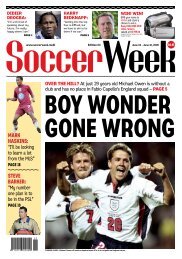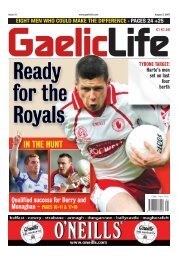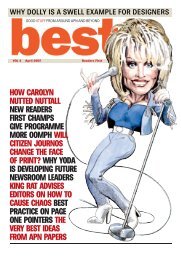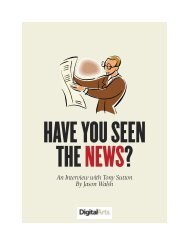CONVERSATION“Then wesee theseinfernalnarrowcolumnsthat havebecomeso popular<strong>with</strong>designers …Readingthat is likewalkingdown astaircase<strong>with</strong>regularsteps,but thenhitting ashorter oneandbumpingdown <strong>to</strong>the bot<strong>to</strong>m.It’sirritatingand it’sdoggonenearpainful”had a fight. Then the San Jose <strong>News</strong> had a bigger fightbecause they wanted <strong>to</strong> reduce the column width <strong>to</strong> 11picas. AP said, “No soap.” Well, Pete Southam, whohad just retired as head honcho at Southam newspapersin Canada, was interested in typography so heinvited me <strong>to</strong> Ottawa and asked what we could doabout the problem. I said, “Pete you’re president ofCanadian Press, surely you’ve got some clout.” Heasked me for the answer. I <strong>to</strong>ld him the solution was assimple as changing the margin release on a typewriter.It was that easy, no matter what CP or AP said. So Peteused his clout and Canadian Press went <strong>to</strong> 11 picacolumns. Then the people down here said, “If thoseCanadians can do it, why the hell can’t we?” and, veryreluctantly, AP changed its transmission <strong>to</strong> 9 at 11. Itwas like moving the pyramids five yards <strong>to</strong> the south.Sut<strong>to</strong>n: We spoke earlier about the need <strong>to</strong> turn lookersin<strong>to</strong> readers, but wouldn’t you agree that we alsohave <strong>to</strong> take care that we don’t oversimplify everything<strong>to</strong> the point of irrelevance?<strong>Arnold</strong>: That’s the distinction that we have <strong>to</strong> reiterateconstantly, that there are viewers and there are readers.And they are not identical functions or identicalroles. It sounds so tiresome <strong>to</strong> keep repeating this, butyou’ve got <strong>to</strong> get back <strong>to</strong> the basics again. People are<strong>to</strong>tally ignorant of the his<strong>to</strong>ry of our craft, which is anhonorable one. The printer is the schoolteacher of theworld, but we don’t learn or understand our own his<strong>to</strong>rybecause no one teaches us. There are alwaysbright spots, like when I was working <strong>with</strong> La Pressein Montreal. The publisher at the time was an elderlyFrench version of Conrad Black, and she was sitting ina lot of meetings. During one, we were trying <strong>to</strong> comeup <strong>with</strong> a new headline type. French words are longerthan English, and I was trying <strong>to</strong> get a legible typefacethat would enable the heads <strong>to</strong> fit properly. I asked thepublisher why her paper hadn’t developed headlineselike American papers, who’d say something like “Ikegoes <strong>to</strong> NATO,” whereas La Presse would say, “Monsieurle President Eisenhower …” Well, madamealmost fainted, so I dropped that ball very quickly. Later,one of my hosts <strong>to</strong>ok me outside her office wherethere was a plaque from the French Academy honoringmadam for her valiant efforts <strong>to</strong> preserve the purityof the French language. There’s a lesson there.Sut<strong>to</strong>n: You’ve redesigned many newspapers in yourtime. Talk about some of your experiences and those ofthe other newspaper design pioneers.<strong>Arnold</strong>: There was a guy, Deacon Farrar, who had beenthe No. 1 newspaper designer for years. When he went<strong>to</strong> redo The Detroit <strong>News</strong> in the late ’40s,he got a suiteat the Hotel Cadillac, then the city’s best hotel. He hadno contact <strong>with</strong> the staff of the paper and only spoke <strong>to</strong>the publisher immediately after he talked <strong>to</strong> God. Hewas in Detroit for weeks, pasting up pages in his suite,but he alienated the staff <strong>with</strong> his memos so much that<strong>with</strong>in two months the only trace of Farrar’s footstepswas a funny little sideless box he had designed; everythingelse moved back <strong>to</strong> what it was before.Well, I saw this from the outside, and it taught mea lesson: get the staff involved fast because they’re justas smart as you are, probably a little smarter. So oneof the things that I always did was ask that somebodywould come up <strong>with</strong> a headline schedule and get themworking on anything else they could possibly do. Myidea was get in there, get the job done and get the hellout as soon as I’d done the job properly.I had a colleague at Virginia Commonwealth Universitywho worked for two years on a redesign of astate newspaper. Two years on one job? Well, a lot ofthis is management, which likes <strong>to</strong> procrastinate. So,I’d go in <strong>to</strong> whoever had <strong>to</strong> make the decisions and say,“Look here, we’ve got <strong>to</strong> get this all set now becauseI’m catching a plane in a couple of hours, and we can’tdo anything until you sign off.” And it would work.There are many ways <strong>to</strong> move publishers. I redesignedThe Toron<strong>to</strong> Star when Beland Honderichwas the publisher. He was a conservative man who didn’tbelieve in doing things that hadn’t been donebefore. We completed the redesign, complete <strong>with</strong>stylebook and a new nameplate – which, incidentally,they still use after all these decades. Everything wasall set, but he couldn’t bring himself <strong>to</strong> push the but<strong>to</strong>n.Then the word came out that The Globe and Mailwas building a new plant, and they would be comingup <strong>with</strong> a new design. That was that, Beland pushedthe but<strong>to</strong>n, and bam, bam, bam, there we were.But it’s always a good idea <strong>to</strong> make sure everythingis set up in advance. When Gannett bought a littleweekly in Titusville, Florida, <strong>to</strong> convert in<strong>to</strong> a dailycalled Today, it had staff on duty for at least a month,putting out a paper every day up <strong>to</strong> the point of droppingit off at the carrier spots. Then somebody wouldcome right up behind, picking them up fast. The firstday the paper came out they were hit by a hurricane.The staff did a terrific job because they had got plentyof training in putting the paper out every day.On the other hand, I was at another paper on LongIsland that had committed <strong>to</strong> a start-up date. I wasthere a week before the launch date, and the new, reconditioned,press was still not running. This was thelast days of the newspaper wars, and only half thepapers – a Sunday edition – got out. It was a <strong>to</strong>tal messbecause they just wouldn’t take another week <strong>to</strong> getthe job running properly.Then we had the extreme on the other side when ElMundo started in San Juan, Puer<strong>to</strong> Rico. It had a fullstaff in operation for a year and put out a paper up <strong>to</strong>platemaking every day. And that was <strong>to</strong>o long becausethey lost a lot of good people who got bored and said,“What the hell is this?” But when they did start theyhad a veteran staff. And it wasn’t <strong>to</strong>tally Mickey Mousebecause there was another morning newspaper in thesame shop, so they were also working for El Vocero,which had kept <strong>to</strong> the same design I had given them 22years earlier.
CONVERSATION<strong>Ed</strong> <strong>Arnold</strong> gets a standing ovation as he goes <strong>to</strong> collect his Lifetime Achievement Award at the Minneapolis workshop.Sut<strong>to</strong>n: A good design should last longer than a coupleof years, shouldn’t it?<strong>Arnold</strong>: A colleague put out a book that was very successful.I met him later and asked what he was doing.He <strong>to</strong>ld me he was writing his second book and washaving <strong>to</strong> make so many changes that it bothered him.“Brother,” I replied, “if your first book had been sound,you would have had principles that didn’t have <strong>to</strong> bechanged.” And I have stuck <strong>to</strong> that philosophy constantly.This sounds like bragging, I’m sure, but oncein a while, I go back <strong>to</strong> one of my books and read it andknow I would make no apologies at all if I put it outagain <strong>with</strong> all the words the way they are, just changingthe illustrations. The basic principles don’t changebecause the eye and the brain don’t change. The sameprinciples apply <strong>to</strong> newspapers – if the design is solid,it should survive.Sut<strong>to</strong>n: I believe you were the guy responsible for theinnovative switch from eight columns <strong>to</strong> six columns inNorth American newspapers in the 1960s? How didthat come about?<strong>Arnold</strong>: Way back in Ben Franklin’s day, his old chumGiambattista Bodoni, and the other master printers ofEurope came up <strong>with</strong> the idea of an optimum linelength that was one-and-a-half times the lower casealphabet length. When you translated that in<strong>to</strong> thetype we were using it came <strong>to</strong> 14 picas. When I transformedthe Louisville Courier Journal and TheLouisville Times <strong>with</strong> Norm Isaac in 1964, we came up<strong>with</strong> a six-column format because that gave us 14 picacolumns. Some papers had used six columns for theirfront pages before then, but these were the first ones<strong>to</strong> use the same format right through. But, back <strong>to</strong>Bodoni and Franklin. They also said that the minimumline length should 25 percent less than the optimum,while the maximum line length is 50 percent more, soit all comes out basically <strong>to</strong> character counts of 32, 42and 64 characters. But, <strong>to</strong>day, especially in Canada, Isee pages where the cutlines run clear across thesheet.Sut<strong>to</strong>n: Surely that’s acceptable if it only makes one ortwo lines.<strong>Arnold</strong>: If it is only one line then it’s <strong>to</strong>lerable, but it’sthat terrible jump back <strong>to</strong> the start of the next line thatcauses trouble. Then we see these infernal narrowcolumns that have become so popular <strong>with</strong> designers.I was doing a critique of a publication that shall benameless – even <strong>with</strong> you, because I know this is goingin<strong>to</strong> the designers’ equivalent of the CongressionalRecord. It was using many columns of about five picaswide, which usually means one word per line and a lo<strong>to</strong>f the time that word has <strong>to</strong> be hyphenated. Readingthat is like walking down a staircase <strong>with</strong> regularsteps, but then hitting a shorter one and bumpingCARSTEN GREGERSEN“Everyau<strong>to</strong>mobileis going<strong>to</strong> havefour wheels,and it’sgoing <strong>to</strong>have anengine andwindshieldbecausethat’s thefunction ofthe beast.<strong>News</strong>papers,becausethey allshare thesamefunction,are going<strong>to</strong> basicallybe thesame”







